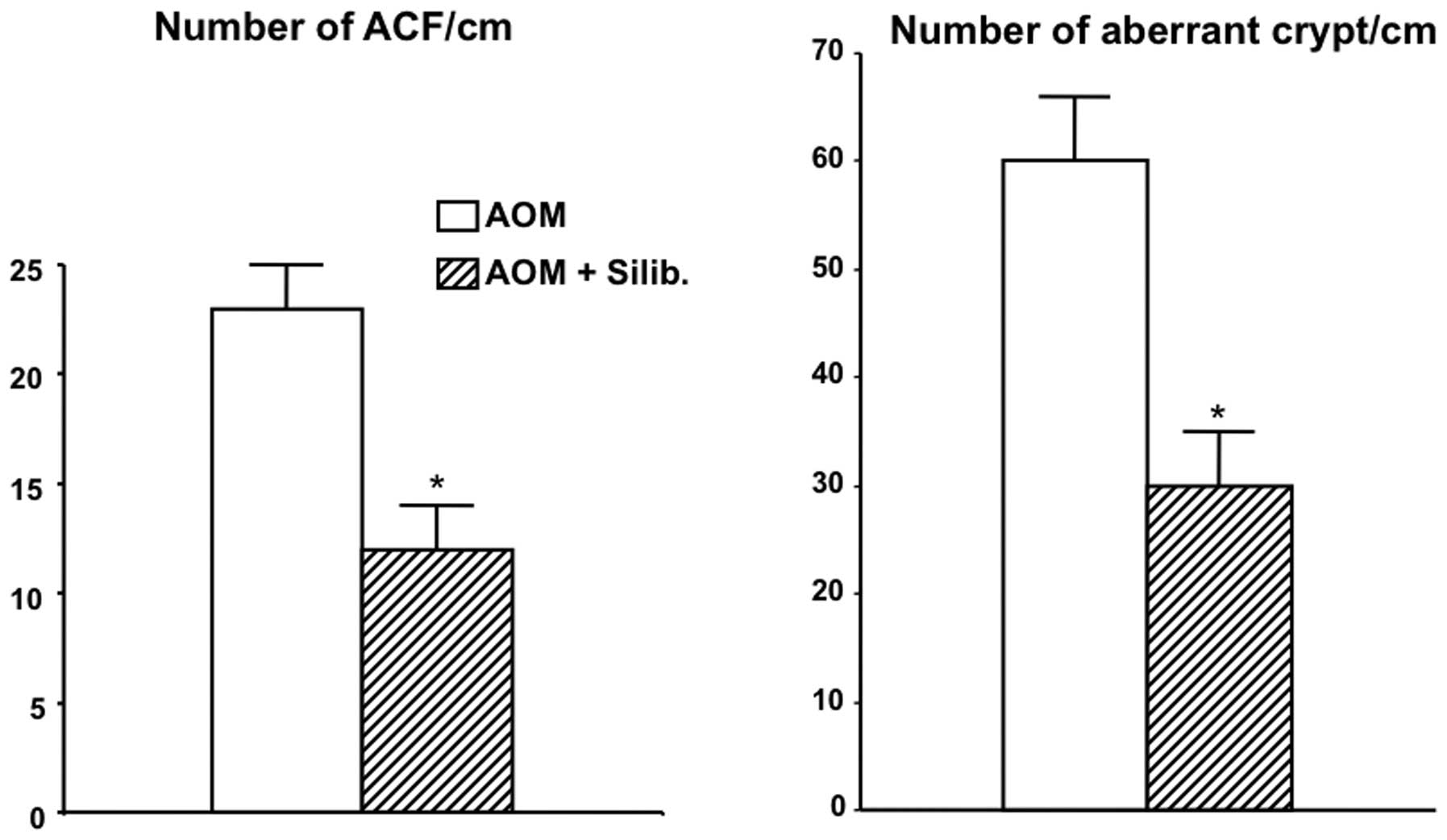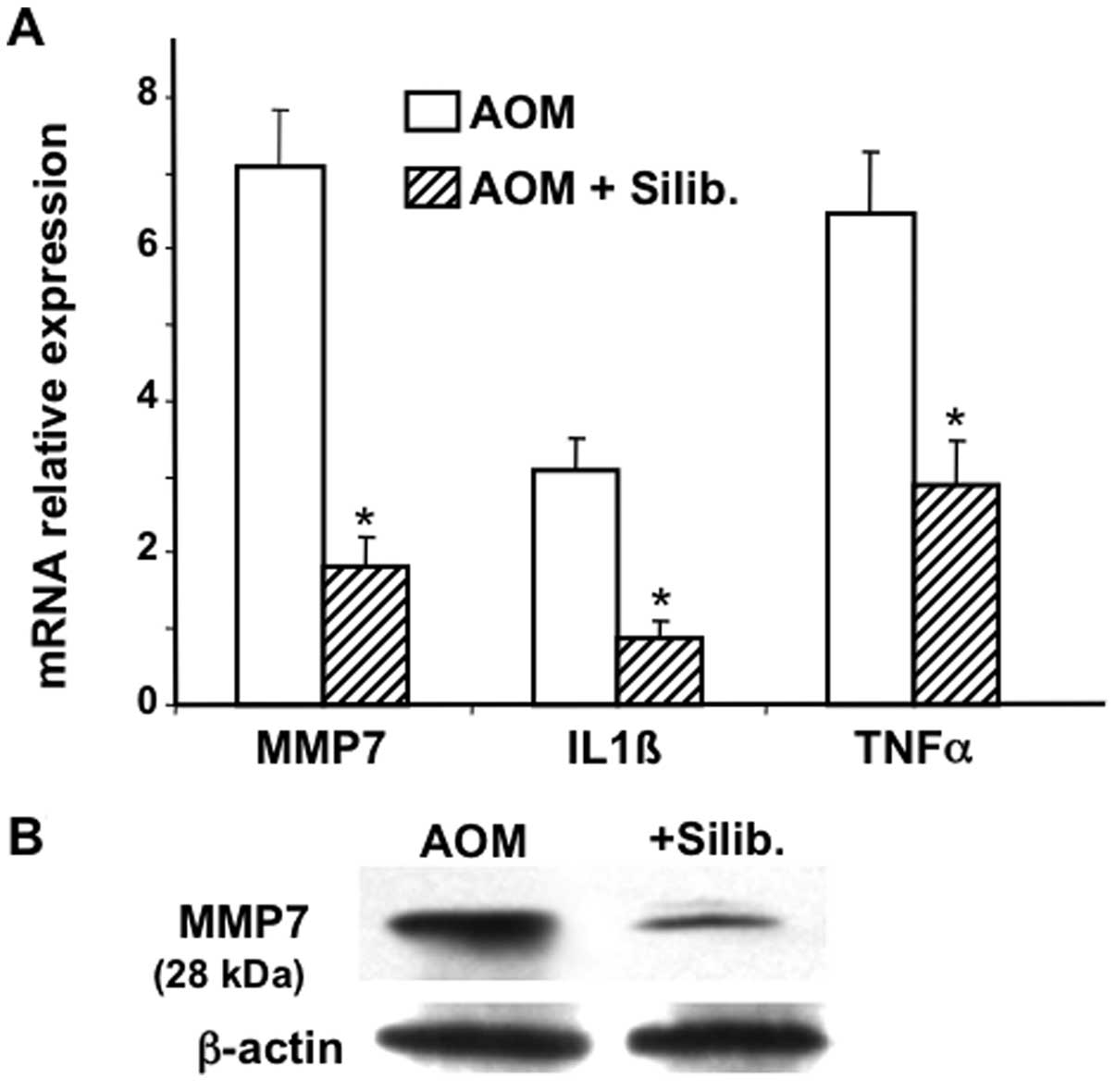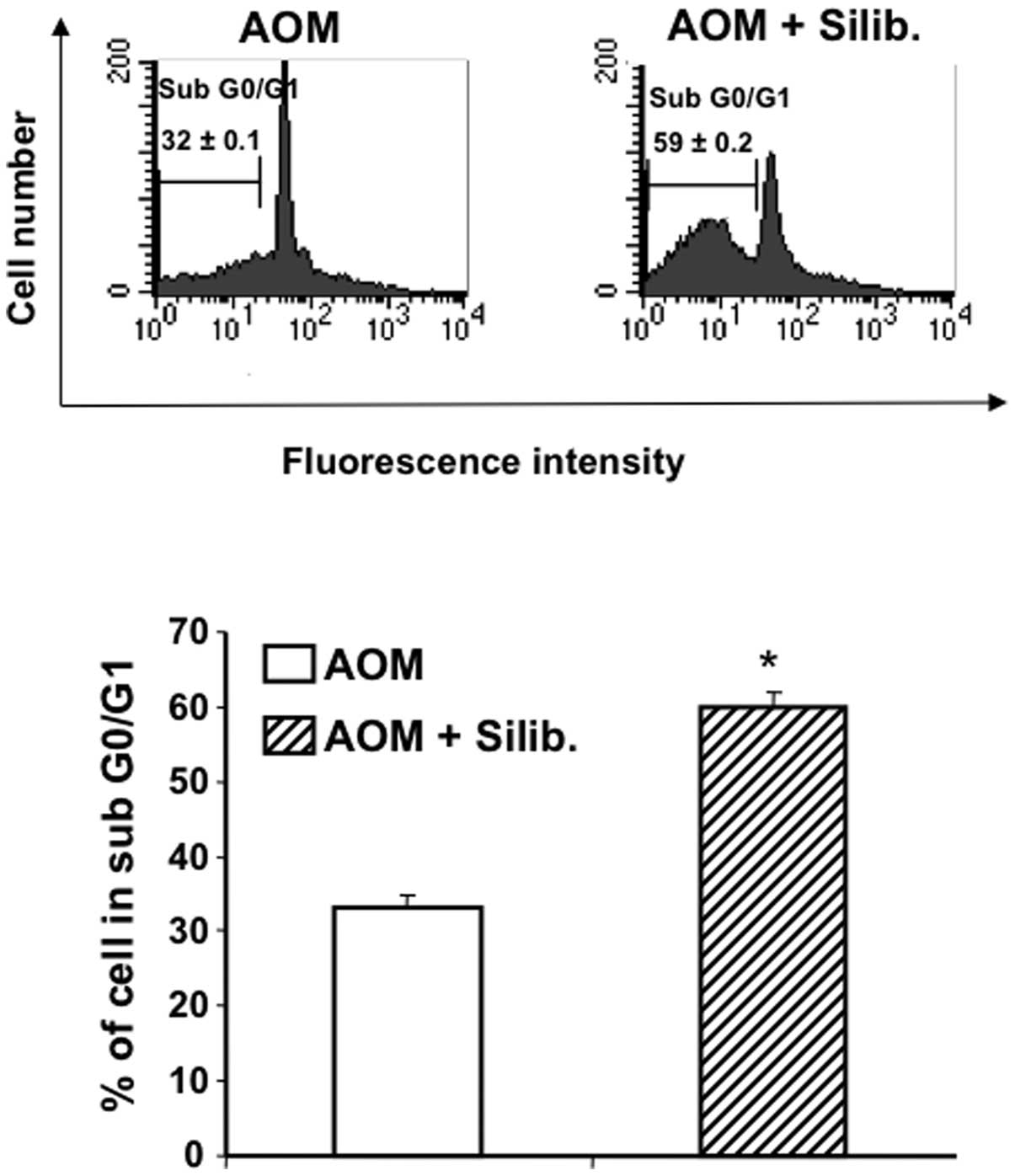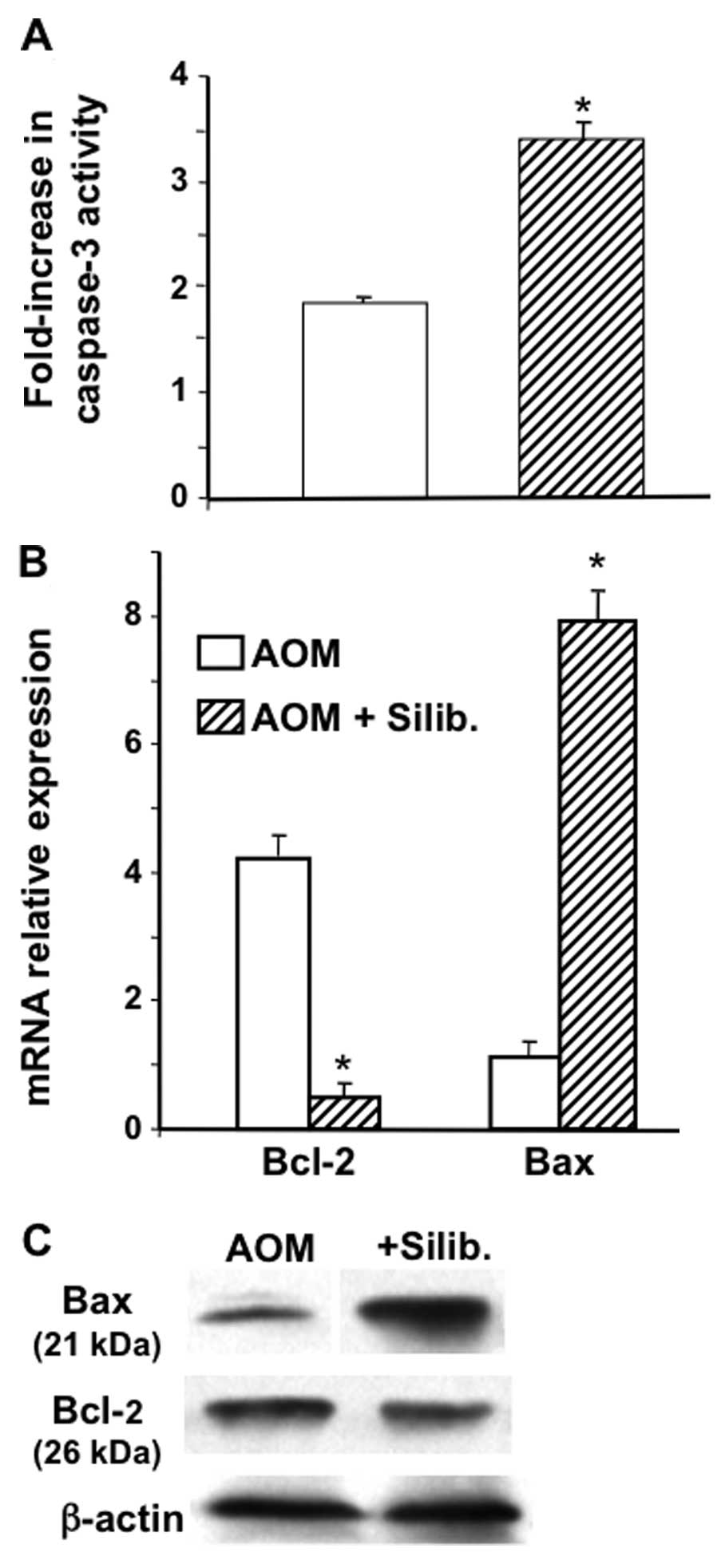|
1
|
Boursi B and Arber N: Current and future
clinical strategies in colon cancer prevention and the emerging
role of chemoprevention. Curr Pharm Des. 13:2274–2282. 2007.
View Article : Google Scholar : PubMed/NCBI
|
|
2
|
Reddy BS: Studies with azoxymethane-rat
preclinical model for assessing colon tumor development and
chemoprevention. Environ Mol Mutagen. 44:26–35. 2004. View Article : Google Scholar : PubMed/NCBI
|
|
3
|
Corpet DE and Pierre F: How good are
rodent models of carcinogenesis in predicting efficacy in humans? A
systematic review and meta-analysis of colon cancer chemoprevention
in rats, mice and humans. Eur J Cancer. 41:1911–1922. 2005.
View Article : Google Scholar : PubMed/NCBI
|
|
4
|
Hoensch HP and Kirch W: Potential role of
flavonoids in the prevention of intestinal neoplasia: a review of
their mode of action and their clinical perspectives. Int J
Gastrointest Cancer. 35:187–195. 2005. View Article : Google Scholar : PubMed/NCBI
|
|
5
|
Terpstra OT, Van Blankenstein M, Dees J
and Eilers GA: Abnormal pattern of cell proliferation in the entire
colonic mucosa of patients with colon adenoma or cancer.
Gastroenterology. 92:704–708. 1987.PubMed/NCBI
|
|
6
|
Risio M, Lipkin M, Candelaresi G, Bertone
A, Coverlizza S and Rossini FP: Correlations between rectal mucosa
cell proliferation and the clinical and pathological features of
nonfamilial neoplasia of the large intestine. Cancer Res.
151:1917–1921. 1999.PubMed/NCBI
|
|
7
|
Pereira MA, Barnes LH, Rassman VL, Kelloff
GV and Steele VE: Use of azoxymethane-induced foci of aberrant
crypts in rat colon to identify potential cancer chemopreventive
agents. Carcinogenesis. 15:1049–1054. 1994. View Article : Google Scholar
|
|
8
|
Bird RP and Good K: The significance of
aberrant crypt foci in understanding the pathogenesis of colon
cancer. Toxicol Lett. 112–113:395–402. 2000.
|
|
9
|
Gazàk R, Walterovà D and Kren V: Silybin
and silymarin - new and emerging applications in medicine. Curr Med
Chem. 14:315–338. 2007.PubMed/NCBI
|
|
10
|
Singh RP and Agarwal R: Mechanisms and
preclinical efficacy of silibinin in preventing skin cancer. Eur J
Cancer. 41:1969–1979. 2005. View Article : Google Scholar : PubMed/NCBI
|
|
11
|
Singh RP and Agarwal R: Prostate cancer
chemoprevention by silibinin: bench to bedside. Mol Carcinog.
45:436–442. 2006. View
Article : Google Scholar : PubMed/NCBI
|
|
12
|
Tyagi A, Singh RP, Ramasamy K, Raina K,
Redente EF, Dwyer-Nield LD, Radcliffe RA, Malkinson AM and Agarwal
R: Growth inhibition and regression of lung tumors by silibinin:
modulation of angiogenesis by macrophage-associated cytokines and
nuclear factor-kappaB and signal transducers and activators of
transcription 3. Cancer Prev Res (Phila). 2:74–83. 2009. View Article : Google Scholar : PubMed/NCBI
|
|
13
|
Velmurugan B, Singh RP, Tyagi A and
Agarwal R: Inhibition of azoxymethane-induced colonic aberrant
crypt foci formation by silibinin in male Fisher rats. Cancer Prev
Res (Phila). 1:376–385. 2008. View Article : Google Scholar : PubMed/NCBI
|
|
14
|
Kaur M, Velmurugan B, Tyagi A, Agarwal C,
Singh RP and Agarwal R: Silibinin suppresses growth of human
colorectal carcinoma SW480 cells in culture and xenograft through
down-regulation of beta-catenin-dependent signaling. Neoplasia.
12:415–424. 2010.PubMed/NCBI
|
|
15
|
Ravichandran K, Velmurugan B, Gu M, Singh
RP and Agarwal R: Inhibitory effect of silibinin against
azoxymethane-induced colon tumorigenesis in A/J mice. Clin Cancer
Res. 16:4595–4606. 2010. View Article : Google Scholar : PubMed/NCBI
|
|
16
|
Kauntz H, Bousserouel S, Gossé F and Raul
F: Silibinin triggers apoptotic signaling pathways and autophagic
survival response in human colon adenocarcinoma cells and their
derived metastatic cells. Apoptosis. 16:1042–1053. 2011. View Article : Google Scholar
|
|
17
|
Bousserouel S, Kauntz H, Gossé F,
Bouhadjar M, Soler L, Marescaux J and Raul F: Identification of
gene expression profiles correlated to tumor progression in a
preclinical model of colon carcinogenesis. Int J Oncol.
36:1485–1490. 2010.PubMed/NCBI
|
|
18
|
Charnley G and Tannenbaum SR: Flow
cytometric analysis of the effect of sodium chloride on gastric
cancer risk in the rat. Cancer Res. 45:5608–5616. 1985.PubMed/NCBI
|
|
19
|
Livak KJ and Schmittgen TD: Analysis of
relative gene expression data using real-time quantitative PCR and
the 2(−Delta Delta C(T)) method. Methods. 25:402–408. 2001.
|
|
20
|
Sier CF, Hawinkels LJ, Zijlmans HJ,
Zuidwijk K, de Jonge-Muller ES, Ferreira V, Hanemaaijer R,
Mulder-Stapel AA, Kenter GG, Verspaget HW and Gorter A: Endothelium
specific matrilysin (MMP-7) expression in human cancers. Matrix
Biol. 27:267–271. 2008.PubMed/NCBI
|
|
21
|
Cawston TE and Wilson AJ: Understanding
the role of tissue degrading enzymes and their inhibitors in
development and disease. Best Pract Res Clin Rheumatol.
20:983–1002. 2006. View Article : Google Scholar : PubMed/NCBI
|
|
22
|
Gunter MJ: Inflammation-related gene
polymorphisms and colorectal adenoma. Cancer Epidemiol Biomarkers
Prev. 15:1126–1131. 2006. View Article : Google Scholar : PubMed/NCBI
|
|
23
|
Buck I, Morceau F, Grigorakaki C, Dicato M
and Diederich M: Linking anemia to inflammation and cancer: the
crucial role of TNFα. Biochem Pharmacol. 77:1572–1579.
2009.PubMed/NCBI
|
|
24
|
Riccardi C and Nicoletti I: Analysis of
apoptosis by propidium iodide staining and flow cytometry. Nat
Protoc. 1:1458–1461. 2006. View Article : Google Scholar : PubMed/NCBI
|
|
25
|
Corpet DE and Tache S: Most effective
colon cancer chemopreventive agents in rats: a review of aberrant
crypt foci and tumour data, ranked by potency. Nutr Cancer.
43:1–21. 2002. View Article : Google Scholar : PubMed/NCBI
|
|
26
|
Pereira MA, Barnes LH, Rassman VL, Kelloff
GV and Steele VE: Use of azoxymethane-induced foci of aberrant
crypts in rat colon to identify potential cancer chemopreventive
agents. Carcinogenesis. 15:1049–1054. 1994. View Article : Google Scholar
|
|
27
|
Pretlow TP, O’Riordan MA, Pretlow TG and
Stellato TA: Aberrant crypts in human colonic mucosa: Putative
preneoplastic lesions. J Cell Biochem. (Suppl)16:G55–G62. 1992.
View Article : Google Scholar : PubMed/NCBI
|
|
28
|
Takayama T, Katsuki S, Takahashi Y, et al:
Aberrant crypt foci of the colon as precursors of adenoma and
cancer. N Engl J Med. 339:1277–1284. 1998. View Article : Google Scholar : PubMed/NCBI
|
|
29
|
Leeman MF, Curran S and Murray GI: New
insights into the roles of matrix metalloproteinases in colorectal
cancer development and progression. J Pathol. 201:528–534. 2003.
View Article : Google Scholar : PubMed/NCBI
|
|
30
|
Lu Q, Jiang B, Lin C and Shan T: Dark
aberrant crypt foci with activated Wnt pathway are related to
tumorigenesis in the colon of AOM-treated rat. J Exp Clin Cancer
Res. 27:262008. View Article : Google Scholar : PubMed/NCBI
|
|
31
|
Tu S, Bhagat G, Cui G, Takaishi S,
Kurt-Jones EA, Rickman B, Betz KS, Penz-Oesterreicher M, Bjorkdahl
O, Fox JG and Wang TC: Overexpression of interleukin-1beta induces
gastric inflammation and cancer and mobilizes myeloid-derived
suppressor cells in mice. Cancer Cell. 14:408–419. 2008. View Article : Google Scholar : PubMed/NCBI
|
|
32
|
Anti M, Armuzzia A, Morinid S, Iasconea E,
Pignataroa G, Cocob C, Lorenzettie R, Paoluccia M, Covinoa M,
Gasbarrinia A, et al: Severe imbalance of cell proliferation and
apoptosis in the left colon and in the rectosigmoid tract in
subjects with a history of large adenomas. Gut. 48:238–246. 2001.
View Article : Google Scholar : PubMed/NCBI
|
|
33
|
Sinicrope FA, Ruan SB, Cleary KR, Stephens
LC, Lee JJ and Levin B: Bcl-2 and p53 oncoprotein expression during
colorectal tumorigenesis. Cancer Res. 55:237–241. 1995.PubMed/NCBI
|
|
34
|
Hanahan D and Weinberg RA: Hallmarks of
cancer: the next generation. Cell. 144:646–674. 2011. View Article : Google Scholar : PubMed/NCBI
|
|
35
|
Singh RP, Tyagi AK, Zhao J and Agarwal R:
Silymarin inhibits growth and causes regression of established skin
tumors in SENCAR mice via modulation of mitogen-activated protein
kinases and induction of apoptosis. Carcinogenesis. 23:499–510.
2002. View Article : Google Scholar : PubMed/NCBI
|
|
36
|
Bousserouel S, Gossé F, Bouhadjar M, Soler
L, Marescaux J and Raul F: Long-term administration of aspirin
inhibits tumour formation and triggers anti-neoplastic molecular
changes in a pre-clinical model of colon carcinogenesis. Oncol Rep.
23:511–517. 2010.
|
|
37
|
Bousserouel S, Lamy V, Gossé F, Lobstein
A, Marescaux J and Raul F: Early modulation of gene expression used
as biomarker for chemoprevention in a preclinical model of colon
carcinogenesis. Path Int. 61:80–87. 2011. View Article : Google Scholar : PubMed/NCBI
|


















